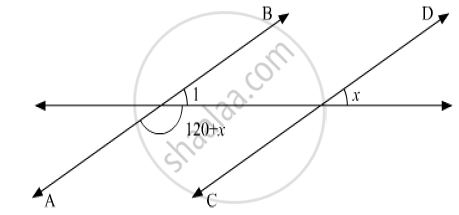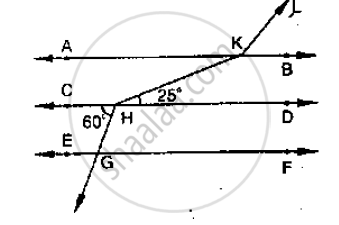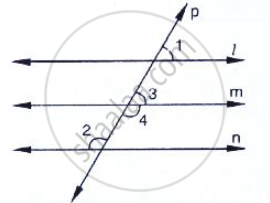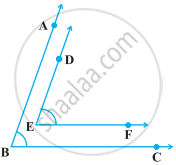Advertisements
Advertisements
Question
In the given figure, if AB || CD, then the value of x is

Options
20°
30°
45°
60°
Solution
Here AB || CD

Also, ∠1 and x are the two corresponding angles.
Then, according to the Corresponding Angles Axiom, which states:
If a transversal intersects two parallel lines, then each pair of corresponding angles are equal.
Therefore,
∠1 = x
Also, ∠1 and (120° + x) form a linear pair, therefore, their sum must be supplementary.
Therefore,
∠1 + (120° + x) = 180°
On substituting ∠1 = x in equation above, we get:
x + 120° + x = 180°
2x + 120° = 180°
2x = 180° - 120°
2x = 60°
`x = (60°)/2`
x = 30°
APPEARS IN
RELATED QUESTIONS
In the below fig, AB || CD || EF and GH || KL. Find `∠`HKL

In the below fig, if l || m || n and `∠`1 = 60°, find `∠`2.

Which pair of lines in the below fig, is parallel? Given reasons.

In the given figure, PQ || RS, ∠AEF = 95°, ∠BHS = 110° and ∠ABC = x°. Then the value of x is

In the given figure, if l1 || l2 and l3 || l4, what is y in terms of x?

In the given figure, if l || m, then x =

AB and CD are two parallel lines. PQ cuts AB and CD at E and F respectively. EL is the bisector of ∠FEB. If ∠LEB = 35°, then ∠CFQ will be
In the given figure, If line segment AB is parallel to the line segment CD, what is the value of y?

Two lines l and m are perpendicular to the same line n. Are l and m perpendicular to each other? Give reason for your answer.
In the following figure, BA || ED and BC || EF. Show that ∠ABC = ∠DEF
[Hint: Produce DE to intersect BC at P (say)].

